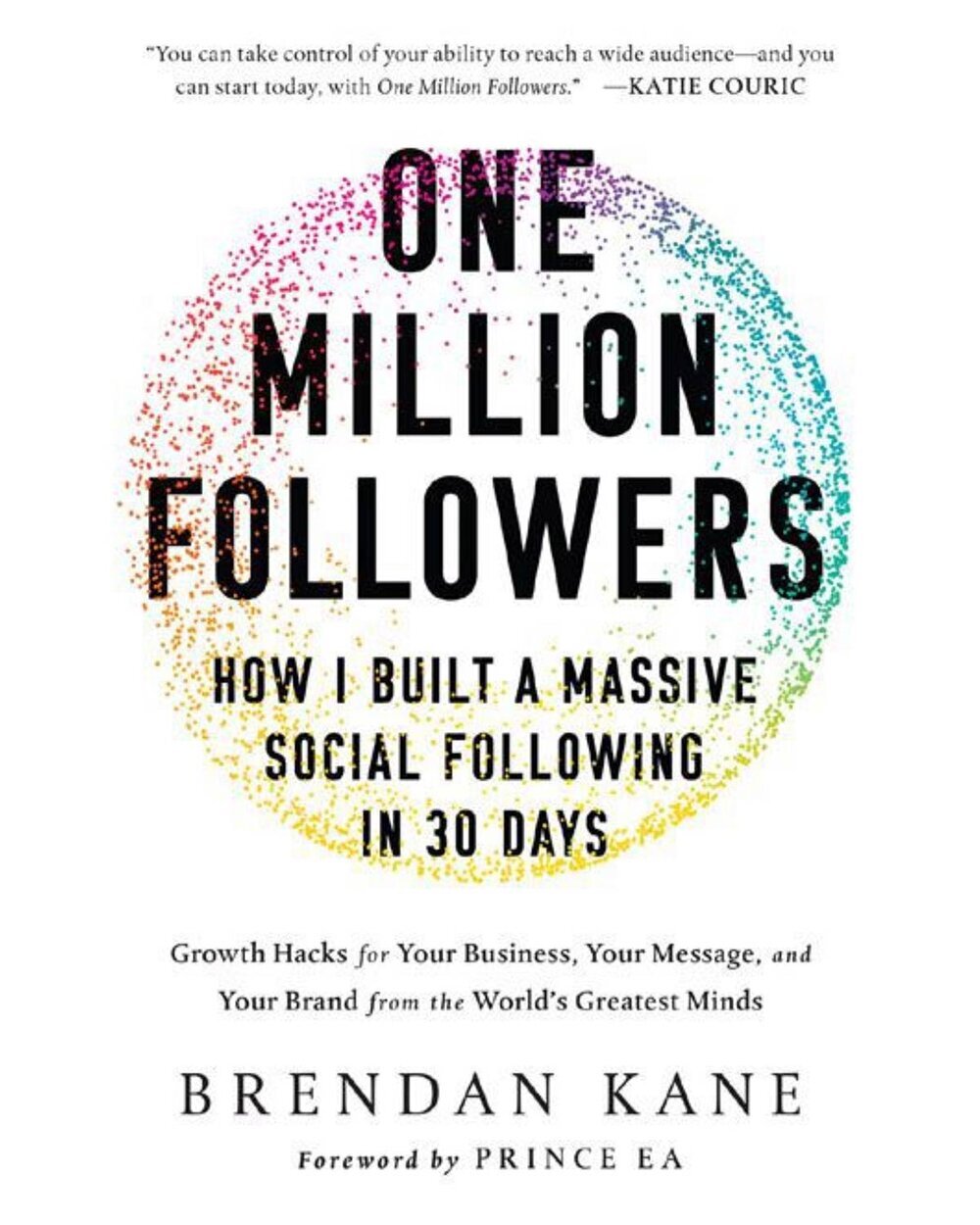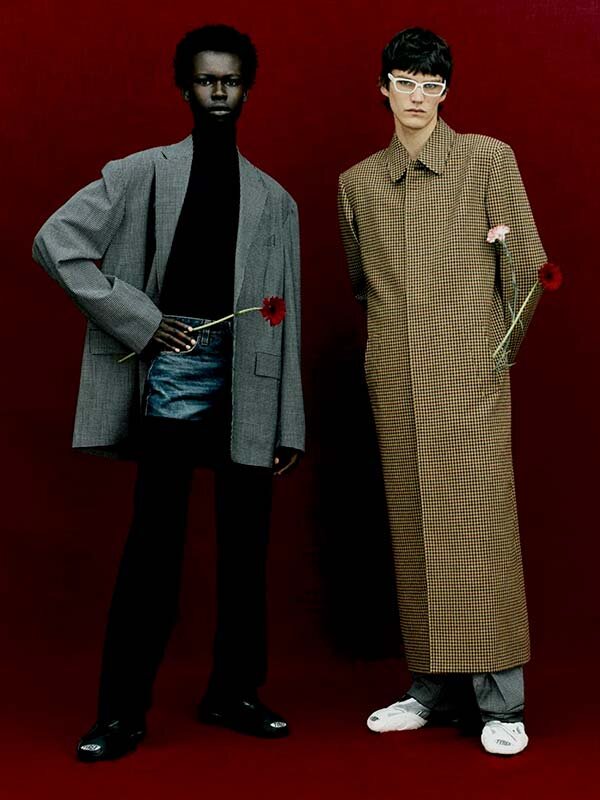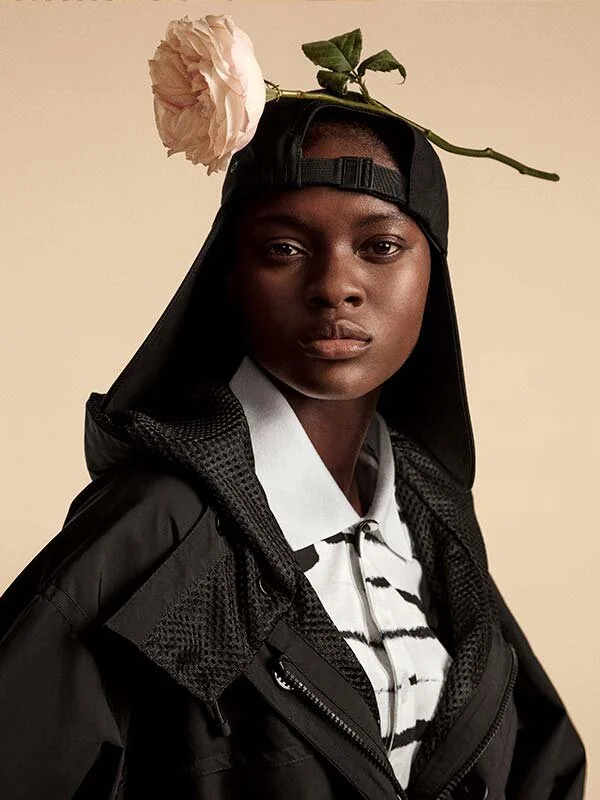Book Club: One Million Followers (Part 3)
12 min read | Book Club | A.M.
In last week’s article, we continued our look at One Million Followers by Brendan Kane, covering key concepts from Chapter 2. We identified motivations for building a massive following as well as the difficulties inherent with reaching audiences using the Facebook/Instagram algorithms. We explored how buyer behavior toward fashion brands is not all that different from laptop computers and organic produce. We then defined what a marketing persona might look like using Brendan’s advice and compared our notes to one of our admitted fashion crushes, Marc Jacobs.
In today’s installment, we’ll look at Chapter 3 and discover what it takes to create great messaging. We’ll then compare our notes to some of our industry’s leading standards and practices, as well as design a campaign message for a fictitious brand. And while it gets a bit dense at times, remember: All the best things come to those who read. At least, that’s our mantra whilst plumbing the depths of the internet.
“You must create content that keeps your followers wanting more, that resonates with their interests, and that gets them to share your brand at the highest possible velocity.”
Finding Neverland
Chapter 3 starts out with what would later develop into Brendan’s follow-up book entitled Hook Point: How To Stand Out In A 3-Second World. Essentially, a hook point is a headline, still image, video, copy, or any combination of thereof, that embodies the essence of your message and instantly engages an audience. The concept is nothing new, but remains vital nonetheless, especially when paired with insights gleaned from Brendan’s experience growing social followings for celebrities and large companies with equally large ad spends.
Brendan begins with the importance of well crafted headlines. While this is perhaps self-evident in a clickbait world, it’s good to be reminded why this is important and how to utilize this effectively and ethically. Brendan writes, “Remember, there are more than sixty billion messages sent out every day. Your hook point needs to help you STAND OUT.” (pg. 64, Kindle Edition) He then offers several anecdotes related to the film industry, though his reference to Tim Ferriss stands out.
Tim Ferriss is an author and “life-hacker” whose podcast has been one of the highest rated over the last decade. You might have heard of some of his books, primarily his 4-Hour series, but it’s the story behind his first book’s title that’s worth reviewing here.
The 4-Hour Workweek: Escape 9-5, Live Anywhere, And Join The New Rich came out in 2007 and has become a household title for its ability to instantly convey a concept that many of us desire. Who wouldn’t want to get rich working four hours a week? But the original title was quite different, and may not have conveyed Tim’s message as instantly or effectively. After all, Drug Dealing For Fun & Profit—which was the book’s first title in reference to Tim’s previous company—sounds provocative, and might gain attention, but doesn’t instantly transmit the essence of the message: work less, get rich, live anywhere.
Developing an excellent message requires a keen understanding of your target audience, which is precisely why we spent so much of the previous article developing a granular approach to a marketing persona. Brendan takes this a step further as he references the Process Communication Model® (PCM) developed by psychologist, author, and presidential communications advisor Dr. Taibi Kahler. Brendan writes:
“The biggest mistake I see people make, and that I help correct when working with clients, is creating content through the lens of how they perceive the world and failing to recognize that much of the population perceives the world in a different way. Thus, their messages don’t get across clearly. . . .This is where the PCM comes in handy.” (pg. 67, Kindle Edition)
What is PCM? Simply put, it’s a way of segmenting your audience into personality types so that you can better craft your messages for their specific communication style. The personality types, along with Brendan’s preferred communication methods, are as follows:
Thinkers—use logic;
Persisters—use value;
Harmonizers—use compassion;
Imaginers—use imagination;
Rebels—use humor;
Promoters—use charm.
If you’d like to go down the PCM rabbit hole, Magda Tabac has some very approachable and well detailed articles that make short work of a broad topic.
This is a very powerful tool, not simply because it allows us to create a specific message in the language of our preferred audience, but because this gives us a framework to truly step outside ourselves and see the world from a fresh perspective.
Gold Digging
Keyhole are an analytics company providing social media insights as well as software that allows you to track your campaign performance. In this article they’ve comprised a rather obvious list of tools one can implement into their marketing mix to stay relevant throughout our holiday season. But perhaps more interesting is their list of businesses that have outperformed market expectations on metrics including social impressions and Return-On-Ad-Spend (ROAS).
Keyhole’s list “Top 5 Fashion Social Media Campaigns in 2020” were as follows: DKNY, Prada, Louis Vuitton, Michael Kors, and Savage X Fenty. Key among the correlations were strong influencer relationships; TikTok implementation; alignment with causes; and combining digital and physical assets and talent into unique experiences, as with Prada’s partnership with influencer Charli D’Amelio whom used TikTok during Milan Fashion Week to share the brand with her then 101.8-million-strong following (as you may have guessed, it’s gone up since February).
In each case, businesses identified their campaign’s target audience and created hook points that spoke directly to them in ways that created excitement, delight, awareness, and encouraged sharing. In addition, they implemented social media into the context of a much larger campaign strategy that aligned with their stated business goals.
Harper’s Bazaar, Elle UK, The Cut, and WWD have published their lists of favorite ads of 2020 measured by their respective editor’s aesthetic preferences, and are well worth the read, especially this one from PAPER. But before going any further, let’s have a quick survey of the industry’s visual messaging.
sampling of visual messaging from some of the world’s most recognizable fashion brands. Each image tells a unique brand story featuring a clear persona that sets a strong tone for a specific audience.
What’s interesting to note at this stage is the general consistency with which large fashion houses advertise their brand stories. From the approachable surrealism of JW Anderson’s AW20 campaign; to the high-concept high fashion of Fendi’s AW20 campaign; to the rebellious individualism seen in Saint Laurent’s SS20 campaign featuring Remi Malek fresh from Bohemian Rhapsody fame; to the strength and sexuality seen in Savage X Fenty’s AW20 Campaign; to the juxtaposed concepts of conservatism and postmodernity seen in Stella McCartney’s SS21 campaign—each present the idea of a brand persona most likely to connect with a targeted audience in the communication style they most identify with.
Objectively speaking—and with all due respect—the most common denominator from a ten-thousand-foot-view is the fact that we’re looking at still images of generally expressionless people within some discernible location wearing apparel and accessories. But far more important—paramount over every other consideration—is the one thing each of these images’ messaging (hook points) have in common: They each evoke an immediate, visceral, and emotional reaction because they were designed from the start to speak, not to the prefrontal cortex, but to the heart.
The New Charity
For those in the nonprofit space, it can be incredibly difficult to gain the attention you need to fuel your mission to create a better world.
Traditional messaging has featured images and copy that focus on the devastating realities that NGOs witness on a daily basis, including violence toward women and young people, ongoing civil wars, mass starvation, and crimes against humanity. These are extremely urgent matters that require the world’s immediate attention, and as such, it’s understandable why organizations flood our news feeds with imagery of this nature.
But what is the immediate reaction to this messaging from those who do not witness devastation on a regular basis? Shock, awe, remorse, perhaps even guilt and shame that they themselves aren’t doing more to help abused and neglected people. For some, images of this nature are triggers that instantly call to mind episodes from their past that cause them great distress. Messages of hope and change can all too often be met by our feelings of guilt and pain and the very obvious reality that many Americans simply don’t have the resources during times of domestic crisis to contribute to charitable causes and organizations.
Certainly many campaigns can find success when touching on empathy, but what about the one’s that don’t? How do you ask for resources and convey a message of hope to a visually fatigued public?
“If you really want to impact people’s lives—if you really want to lift them out of extreme poverty—water is the best way to do it.”
Charity: Water is a nonprofit with radical goals—their mission is to provide clean, safe drinking water to people in developing countries. To do this, they’ve created a business model that actually converts 100% of all donations into measurable results by redirecting those funds into their clean water campaigns, initiatives, and strategic in-country partnerships.
To pay the bills, Charity: Water created a second branch of the organization that receives donations from individuals and companies specifically to pay for things like office space, salaries, and paper clips. And the innovation doesn’t stop there.
Charity: Water founder Scott Harrison has an interesting background. Before founding a nonprofit, Scott was a nightclub promoter in New York who lived a rather stereotypical life of parties, drugs, and mid-morning hangovers. But after reaching a point where he desired change, Scott liquidated his assets, bought a Nikon camera, and moved to Liberia to volunteer with Mercy Ships where he quickly learned the realities of life in a country torn apart by war.
Scott would send images home via his former promoter email list and quickly discovered that his images weren’t well received. He needed to quickly learn how to tell stories about his experiences in the developing world in ways that would resonate with people back home.
In a keynote appearance for INBOUND in 2018, Scott tells Charity: Water’s story in its captivating entirety. Speaking about the global water crisis, he offers the following observation:
“I have learned this is exclusively a women’s issue. Doesn’t matter if I’m in Africa or India or Southeast Asia or Central or South America. It is the role of the women and the girls to get the water. And we see women in the most undignified situations.”
Scott then tells many difficult stories about the realities of dangerous water in some graphic detail. But he also tells the story of a woman from Uganda named Hellen whom he met after a successful campaign to bring clean water to her community. With access to water, Hellen can not only accomplish more, but has been able to care for herself in ways that we in the United States so often take for granted. In addition to a healthier quality of life regarding food preparation and general hydration, Hellen now has enough clean water to wash her own clothes—not just her family’s or her husband’s—and she can even wash her face and bathe herself without fear of depriving her children. “Now, I am beautiful,” she told Scott with immense pride as Scott shows a picture of Hellen with a freshly washed face to the INBOUND audience. Scott explains:
“We believe now more than ever, water changes everything. It is one of the most transformative things on planet Earth. If you really want to impact people’s lives—if you really want to lift them out of extreme poverty—water is the best way to do it.”
As a result of these experiences over the past decade, Charity: Water have consistently chosen an advertising strategy that shines light on the positive effects of clean water for individuals and communities, including efforts to empower women and girls, in ways that delight, inspire, and inform their audience, and encourage them to share with others.
Charity: Water 2020 campaigns featuring recurring themes of celebration and empowerment as they communicate various marketing and organizational messaging to their target audience.
Lingua Franca
Back to the book. Brendan wraps up Chapter 3 with an insightful story about how he created an audience for Katie Couric that eventually enabled him to predict what kind of content and messaging would be most successful in future campaigns. Hint: Lots of A/B testing.
Inc. contributing editor Geoffrey James created a usefully terse checklist for marketing messages. You’ll notice immediately the difference in tone between his editorial voice and ours. Inc. are a publication dedicated to business, and as such, logic and brevity are their preferred language.
There’s quite a lot more that could be said on this topic, but the main thing is simply this: As we approach our campaign messaging, we need to be clear on who we are, where we want to go, and what happens when we get there.
In the end, fashion is about selling clothes to people. But far from a commodity, what you’re actually selling is a vision of a future in which your target audience would be delighted to participate and share with others. How much emphasis you place on either fantasy or reality is a decision you’ll have to make based on your marketing goals.
Rubber Meets Road
Now let’s design a campaign message for a fictitious company around a line of A-line dresses with floral prints made from Tencel that are constructed locally in small batches and will be sold direct-to-consumer on a pre-sale basis. The brand has a clear commitment to ethically produced fashion that follows a sustainable business model with measurable results.
Their marketing persona consists of women ages 24-35 that identify as single, eco-conscious, non-traditional, and are employed full-time at a tech company in a mid-level managerial role. They live in a cool climate with four seasons. They love the outdoors but never go hiking. They love dresses but rarely have the occasion to wear one. They love flowers but rarely receive them. They practice yoga but do not lift weights. They have a sense of humor and appreciate inside jokes with a hint of sarcasm. They are highly technical and prefer Apple products, though many are obligated to use either Android or Windows at work. They follow multiple regional Instagram and TikTok influencers and are very active on Pinterest. And for the sake of brevity, let’s stop here and assume this represents the actual customer base for this made-up company.
First, where do they fall on our PCM list? Since we created the persona, here’s our suggestion: This audience is comprised of Promoters, Thinkers, and Rebels—people who value action and direct communication, but also require facts and organization, and love anything spontaneous and creative. Lots to choose from, so we can A/B test them all and break them up into the following iterations:
Promoters—get to the point. “Dress for a better future.”
Thinkers—wardrobe and sustainability. “More dress, less waste.”
Rebels—Inside jokes and sarcasm. “Buy your own flowers.”
You might expand on some of these themes with more outrageous terminology. But as we said previously, it’s important to align your marketing goals with your brand message, regardless of how cool it might sound to use clickbait in your promotion.
The key to a successful message is its ability to both create a personal connection and inspire a creative team to deliver results. The tone of the messaging will be the cornerstone for everything else downstream, including the creative, so it’s important to get this right.
Dashboard Confession
It’s entirely possible that many reading this now have jumped head-first into designing a fashion line without consulting a Marketing or Branding Agency. You saved a lot of money, for sure. But without the expertise that comes from well regarded industry insiders with a rolodex and a track record, the burden of execution is squarely on your shoulders.
As of this writing, Seattle doesn’t have many options for Public Relations or Creative Agencies that specialize in fashion (this is a tech town, after all). Since this series focuses on small businesses in our area, we’ll move forward with the understanding that you’re on your own—but never alone.
With a little bit of networking and some industry cross-pollination, you can design and implement a marketing mix that will elevate your brand awareness as well as grow your following ethically and sustainably.
Up Next
For those who’ve read through these first three articles, our sincerest thanks. We know what you may be thinking—get to the fun stuff already.
So in the spirit of the holidays, the next article in our Book Club series One Million Followers will cover how to plan a fashion sitting and create multiple deliverables using both video and still imagery intended for release over multiple channels. We’ll cover a brief intro into the world of advertising and identify key components to a successful production—which is, itself, a phenomenally large topic, so we’ll focus on what works within our context.
As of the time of writing, we’re currently living through both an international pandemic and local stay-at-home lockdowns, which have led to the cessation of many of our industry’s key functions. But from the sound of things, that might change for the better after the holidays. So until next week, be excellent to each other. Stay safe :)

















In today’s segment we’ll look at Chapter 2 as Brendan describes the relative ease with which the Facebook platform allows him to target specific individuals and demographics. In addition, we’ll share our own thoughts on the importance of having a well defined marketing persona before going any further downstream.